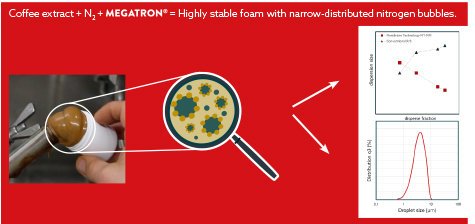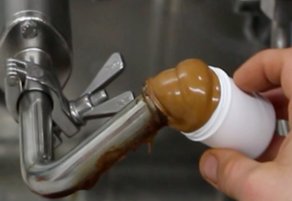Foamed coffee
Application purpose
To achieve a monomodal and stable foam under gentle conditions to avoid flavor loss.
Challenges
- Fully monomodal bubble size expected for increased stability.
- Foam size below 1-10 µm is needed.
- Low processing temperatures to keep flavor loss as low as possible.
How did we achieve it?
In several food products gas bubbles are incorporated to improve texture and/or its appearance. At the same time, there is an increased interest in foamed structures in food products since it helps to reduce the energy density while delivering to the consumer different and better experiences such aroma release or visual enhancing1.
Monodispersed and small bubbles lead to a more stable foam even at high gas fractions2,3.

Final Result
In the case of the conventional rotor-stator foaming units, high gas fractions result in larger bubble sizes decreasing the stability over time of the resulting foam.
On the contrary, the gentle breakup method of the bubble in the membrane technology of Kinematica allows the increase of the gas fraction with simultaneous decrease of the bubble size.

This difference on the detachment method from the surface on both technologies also explains the reduced energy consumption. This reduces the temperature increase and therefore the flavor loss during processing.
The membrane technology has a promising future in different industries to generate monodispersed foams4.
Do you want to have more information? Please contact us here or send us an email to science@kinematica.ch.
1Ellis, Amy & Lazidis, Aris. (2018). Foams for Food Applications.
2Sarma, D. S. H. S. R., & Khilar, K. C. (1988). Effects of initial gas volume fraction on stability of aqueous air foams. Industrial & Engineering Chemistry Research, 27(5), 892–894.
3Müller-Fischer, N. (2007). Dynamically enhanced membrane foaming (p. 238 p.) [ETH Zurich; Application/pdf].
4Carballido, L., Dabrowski, M. L., Dehli, F., Koch, L., & Stubenrauch, C. (2020). Monodisperse liquid foams via membrane foaming. Journal of Colloid and Interface Science, 568, 46–53.
Want to learn more?
- Green, A. J., Littlejohn, K. A., Hooley, P., & Cox, P. W. (2013). Formation and stability of food foams and aerated emulsions: Hydrophobins as novel functional ingredients. Current Opinion in Colloid & Interface Science, 18(4), 292–301.
